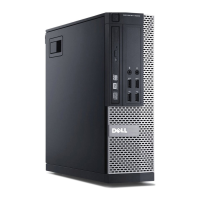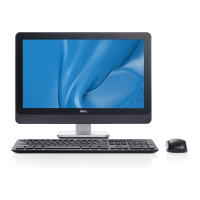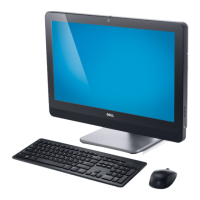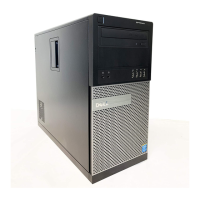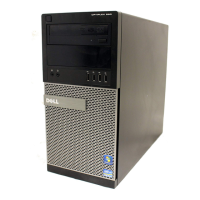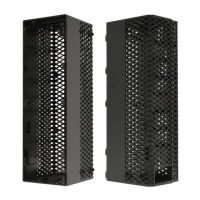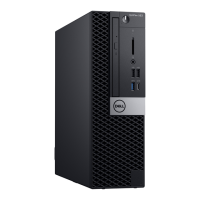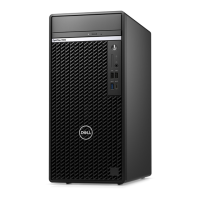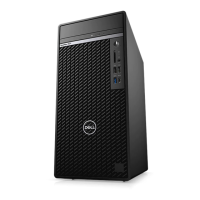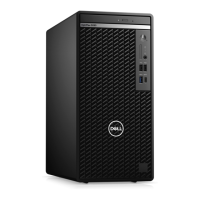Do you have a question about the Dell OptiPlex 9020 Mini Tower and is the answer not in the manual?
Use safety guidelines to protect your computer from potential damage and ensure personal safety.
Procedure to remove the computer cover for internal access.
Procedure to reinstall the computer cover after maintenance.
General guidelines for configuring system memory modules for optimal performance.
Steps to press retaining tabs and lift memory modules out of connectors.
Align notch, press module until tabs spring back to secure memory.
Disconnect cables, press tabs, flex bracket and remove hard drive.
Insert drive into bracket, slide into bay, connect cables, and install bezel/cover.
Disconnect power cables from system board and release cable from tab.
Place PSU in chassis, tighten screws, connect cables, thread cables, install cover.
Press lever, move outward, lift cover, remove processor from socket.
Insert processor, lower cover, secure lever with retention hook.
Disconnect all cables, remove securing screws, slide board towards front to remove.
Align ports, place board, tighten screws, connect cables, install components/cover.
Settings for internal HDD password, strong password, and password configuration.
Configure multi-core support, Intel SpeedStep, C States, CPUID, TurboBoost, Hyper-Threading.
Explains how to create system and setup passwords to secure the computer.
Steps to assign a new system or setup password when status is unlocked.
Steps to alter or delete existing system and setup passwords when status is unlocked.
Procedure to disable system/setup passwords using the PSWD jumper.
Performs a complete hardware check, with options for particular devices or groups.
Interprets the bicolored diagnostic LED on the power button for system status.
Identifies various problems through a series of beeps during start-up.
Lists common error messages and their descriptions and potential causes.
| Tcase | 72.72 °C |
|---|---|
| Bus type | DMI |
| Stepping | C0 |
| Processor cache | 8 MB |
| Processor cores | 4 |
| System bus rate | 5 GT/s |
| Processor family | Intel® Core™ i7 |
| Processor series | Intel Core i7-4700 Desktop series |
| Processor socket | LGA 1150 (Socket H3) |
| Processor threads | 8 |
| Processor codename | Haswell |
| Number of QPI links | 0 |
| Processor frequency | 3.6 GHz |
| Processor cache type | Smart Cache |
| Processor lithography | 22 nm |
| Processor manufacturer | Intel |
| Processor front side bus | - MHz |
| PCI Express slots version | 3.0 |
| Processor boost frequency | 4 GHz |
| Processor operating modes | 32-bit, 64-bit |
| ECC supported by processor | No |
| PCI Express configurations | 1x16, 2x8, 1x8+2x4 |
| Thermal Design Power (TDP) | 84 W |
| Number of processors installed | 1 |
| Maximum number of PCI Express lanes | 16 |
| Memory types supported by processor | DDR3-SDRAM |
| Memory clock speeds supported by processor | 1333, 1600 MHz |
| Memory bandwidth supported by processor (max) | 25.6 GB/s |
| Maximum internal memory supported by processor | 32 GB |
| Non-ECC | Yes |
| Memory slots | 4x DIMM |
| Internal memory | 16 GB |
| Memory channels | Dual-channel |
| Memory clock speed | 1600 MHz |
| SSD capacity | The Solid State Drive's storage capacity in Gigabytes. |
| Storage media | SSD |
| Optical drive type | DVD±RW |
| Total storage capacity | 256 GB |
| Intel segment tagging | Enterprise, Small Business |
| Intel® Virtualization Technology (Intel® VT) | VT-d, VT-x |
| On-board graphics card ID | 0x412 |
| Discrete graphics card model | Not available |
| On-board graphics card model | Intel® HD Graphics 4600 |
| On-board graphics card family | Intel® HD Graphics |
| Maximum on-board graphics card memory | 1.024 GB |
| On-board graphics card base frequency | 350 MHz |
| On-board graphics card DirectX version | 11.1 |
| On-board graphics card dynamic frequency (max) | 1200 MHz |
| Number of displays supported (on-board graphics) | 3 |
| Operating system installed | Windows 7 Professional |
| Operating system architecture | 64-bit |
| Wi-Fi | - |
| Cabling technology | 10/100/1000Base-T(X) |
| Ethernet LAN data rates | 10, 100, 1000 Mbit/s |
| USB 2.0 ports quantity | 6 |
| Chassis type | Mini Tower |
| Product color | Black |
| Placement supported | Vertical |
| Audio system | HD |
| Product type | PC |
| Motherboard chipset | Intel® Q87 |
| Compatible processor series | Intel Core i3, Intel Core i5, Intel Core i7 |
| Scalability | 1S |
| Processor code | SR1QF |
| Processor ARK ID | 80806 |
| Intel TSX-NI version | 0.00 |
| Processor package size | 37.5 x 37.5 mm |
| Supported instruction sets | AVX 2.0, SSE4.1, SSE4.2 |
| Thermal solution specification | PCG 2013D |
| Intel Identity Protection Technology version | 1.00 |
| Power supply | 290 W |
| Power supply input voltage | 100 - 240 V |
| Power supply input frequency | 50 - 60 Hz |
| Operating altitude | -15.2 - 3048 m |
| Non-operating altitude | -15.2 - 10668 m |
| Storage temperature (T-T) | -40 - 65 °C |
| Operating temperature (T-T) | 5 - 35 °C |
| Storage relative humidity (H-H) | 5 - 95 % |
| Operating relative humidity (H-H) | 20 - 80 % |
| Sustainability certificates | RoHS, ENERGY STAR |
| Cables included | AC |
| Depth | 417 mm |
|---|---|
| Width | 175 mm |
| Height | 360 mm |
| Weight | 9400 g |
